Tesco Plc: Strategic Analysis of Marketing Principles and Practice
VerifiedAdded on 2022/12/26
|14
|5096
|1
Report
AI Summary
This report provides a comprehensive strategic analysis of Tesco Plc, a multinational retailer, focusing on its marketing strategies and current market position. It utilizes the SOSTAC model to evaluate the company's situation, objectives, strategy, tactics, actions, and control mechanisms, along with an industrial investigation of the retail sector. The analysis includes a PESTEL analysis to assess the impact of external factors on Tesco's operations, and an objective analysis to determine the company's long-term goals. Furthermore, the report examines the effectiveness of Tesco's current SOSTAC strategy and explores its marketing tactics, including pricing, product, and placement strategies. The report identifies shortcomings in the existing strategy and offers recommendations considering the current market scenario to enhance Tesco's competitive advantage and regain stakeholder trust. The analysis is supported by academic literature and relevant sources to provide profound details about the company's strategic situation and future opportunities.
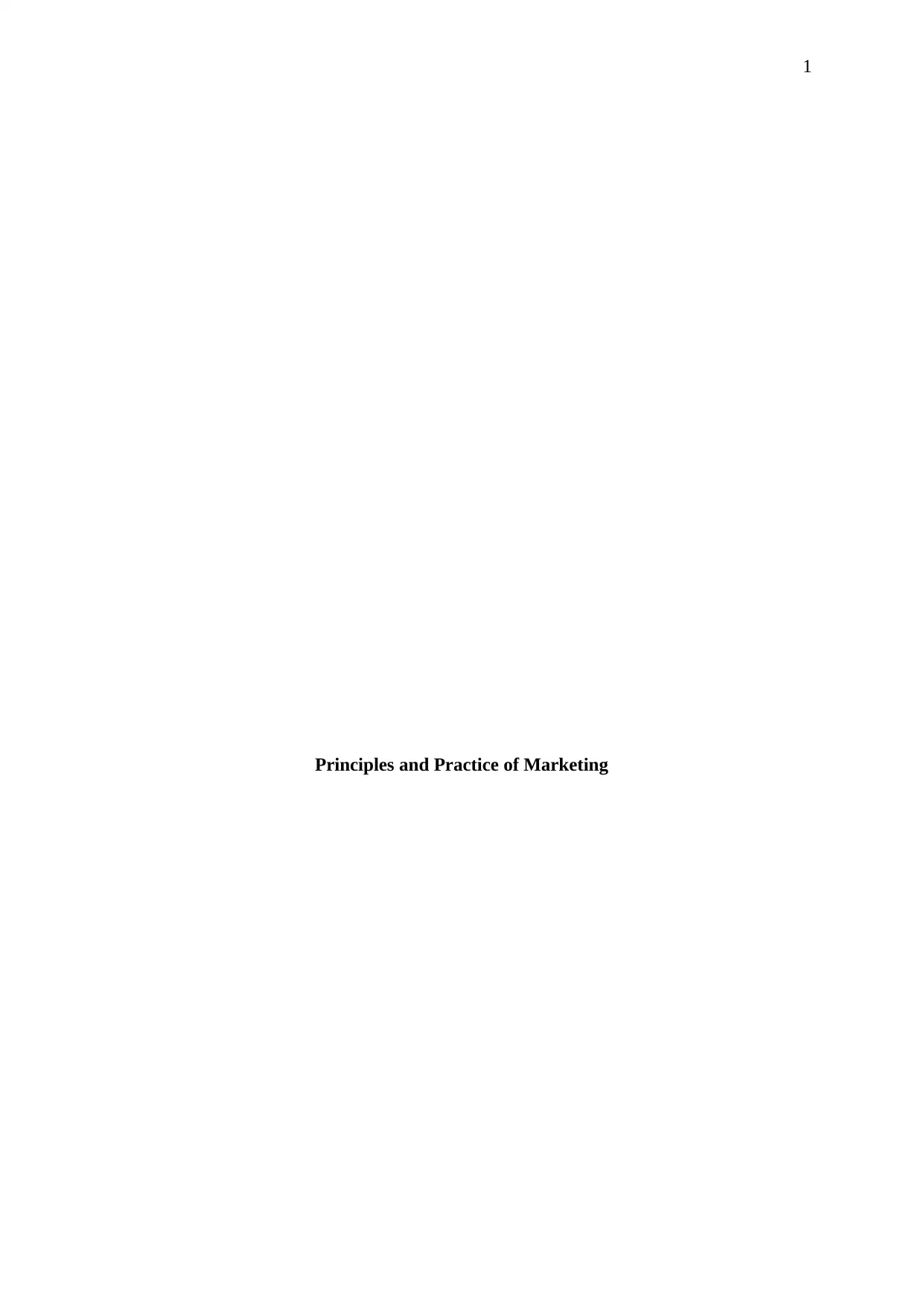
1
Principles and Practice of Marketing
Principles and Practice of Marketing
Paraphrase This Document
Need a fresh take? Get an instant paraphrase of this document with our AI Paraphraser
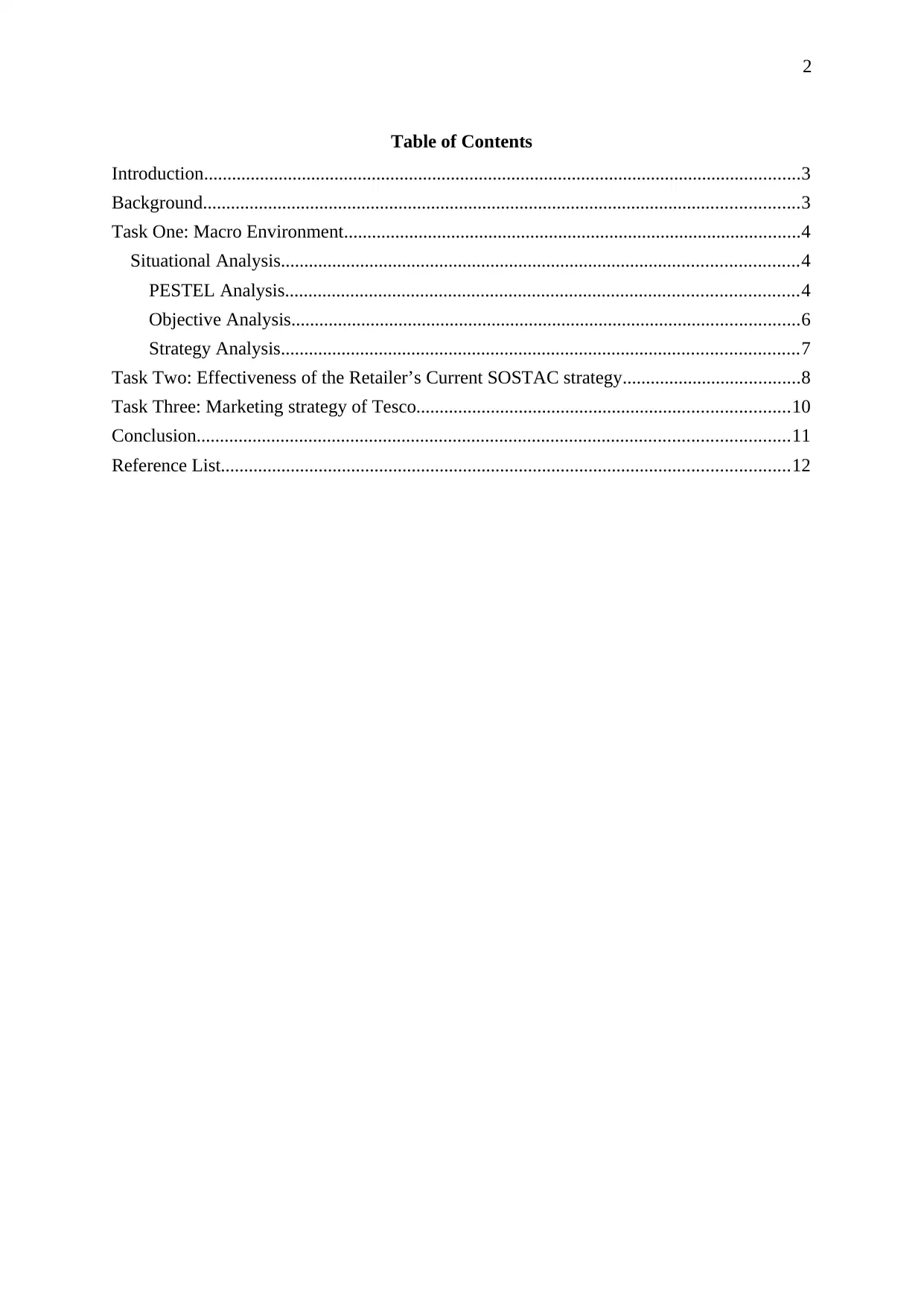
2
Table of Contents
Introduction................................................................................................................................3
Background................................................................................................................................3
Task One: Macro Environment..................................................................................................4
Situational Analysis...............................................................................................................4
PESTEL Analysis..............................................................................................................4
Objective Analysis.............................................................................................................6
Strategy Analysis...............................................................................................................7
Task Two: Effectiveness of the Retailer’s Current SOSTAC strategy......................................8
Task Three: Marketing strategy of Tesco................................................................................10
Conclusion...............................................................................................................................11
Reference List..........................................................................................................................12
Table of Contents
Introduction................................................................................................................................3
Background................................................................................................................................3
Task One: Macro Environment..................................................................................................4
Situational Analysis...............................................................................................................4
PESTEL Analysis..............................................................................................................4
Objective Analysis.............................................................................................................6
Strategy Analysis...............................................................................................................7
Task Two: Effectiveness of the Retailer’s Current SOSTAC strategy......................................8
Task Three: Marketing strategy of Tesco................................................................................10
Conclusion...............................................................................................................................11
Reference List..........................................................................................................................12
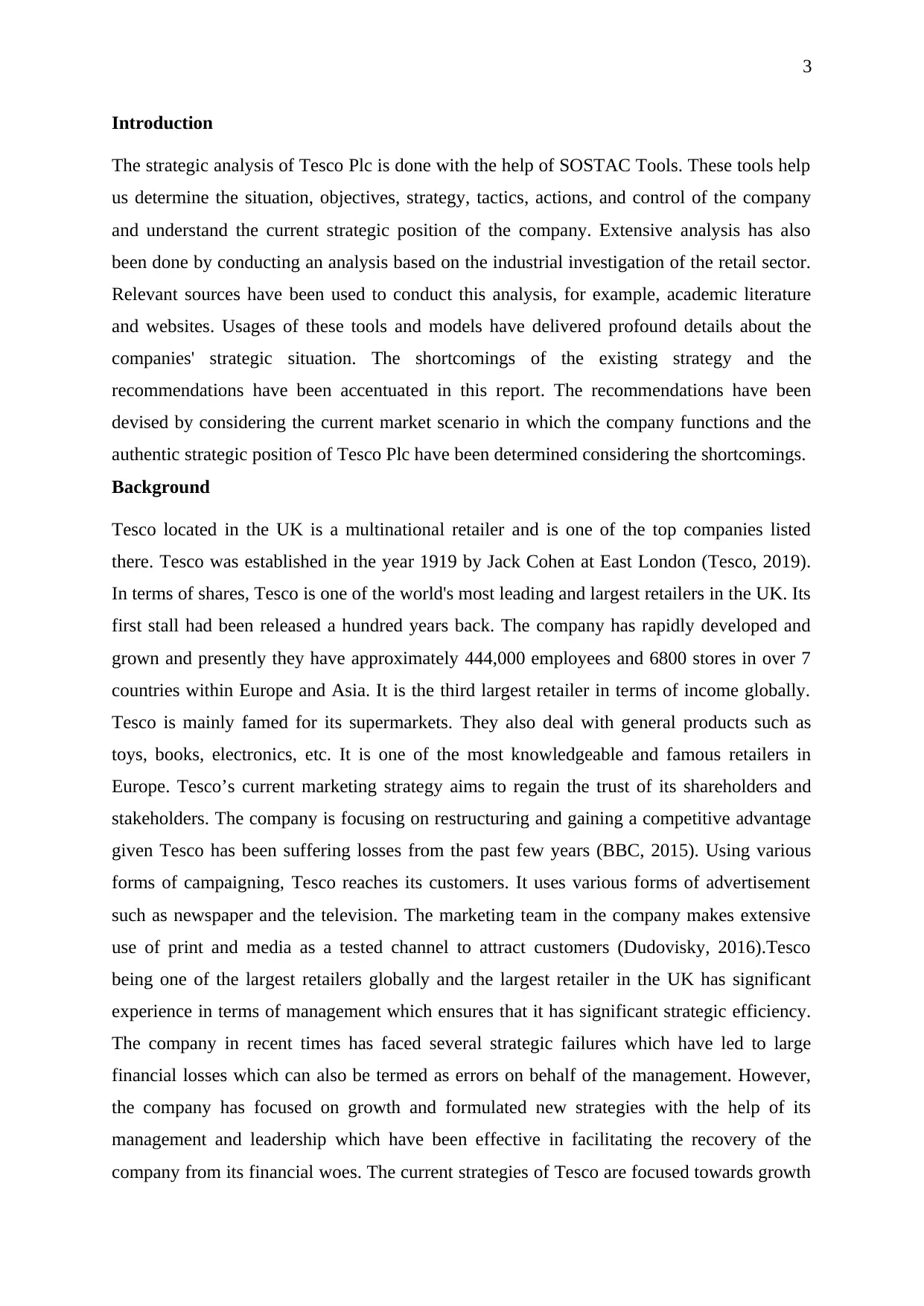
3
Introduction
The strategic analysis of Tesco Plc is done with the help of SOSTAC Tools. These tools help
us determine the situation, objectives, strategy, tactics, actions, and control of the company
and understand the current strategic position of the company. Extensive analysis has also
been done by conducting an analysis based on the industrial investigation of the retail sector.
Relevant sources have been used to conduct this analysis, for example, academic literature
and websites. Usages of these tools and models have delivered profound details about the
companies' strategic situation. The shortcomings of the existing strategy and the
recommendations have been accentuated in this report. The recommendations have been
devised by considering the current market scenario in which the company functions and the
authentic strategic position of Tesco Plc have been determined considering the shortcomings.
Background
Tesco located in the UK is a multinational retailer and is one of the top companies listed
there. Tesco was established in the year 1919 by Jack Cohen at East London (Tesco, 2019).
In terms of shares, Tesco is one of the world's most leading and largest retailers in the UK. Its
first stall had been released a hundred years back. The company has rapidly developed and
grown and presently they have approximately 444,000 employees and 6800 stores in over 7
countries within Europe and Asia. It is the third largest retailer in terms of income globally.
Tesco is mainly famed for its supermarkets. They also deal with general products such as
toys, books, electronics, etc. It is one of the most knowledgeable and famous retailers in
Europe. Tesco’s current marketing strategy aims to regain the trust of its shareholders and
stakeholders. The company is focusing on restructuring and gaining a competitive advantage
given Tesco has been suffering losses from the past few years (BBC, 2015). Using various
forms of campaigning, Tesco reaches its customers. It uses various forms of advertisement
such as newspaper and the television. The marketing team in the company makes extensive
use of print and media as a tested channel to attract customers (Dudovisky, 2016).Tesco
being one of the largest retailers globally and the largest retailer in the UK has significant
experience in terms of management which ensures that it has significant strategic efficiency.
The company in recent times has faced several strategic failures which have led to large
financial losses which can also be termed as errors on behalf of the management. However,
the company has focused on growth and formulated new strategies with the help of its
management and leadership which have been effective in facilitating the recovery of the
company from its financial woes. The current strategies of Tesco are focused towards growth
Introduction
The strategic analysis of Tesco Plc is done with the help of SOSTAC Tools. These tools help
us determine the situation, objectives, strategy, tactics, actions, and control of the company
and understand the current strategic position of the company. Extensive analysis has also
been done by conducting an analysis based on the industrial investigation of the retail sector.
Relevant sources have been used to conduct this analysis, for example, academic literature
and websites. Usages of these tools and models have delivered profound details about the
companies' strategic situation. The shortcomings of the existing strategy and the
recommendations have been accentuated in this report. The recommendations have been
devised by considering the current market scenario in which the company functions and the
authentic strategic position of Tesco Plc have been determined considering the shortcomings.
Background
Tesco located in the UK is a multinational retailer and is one of the top companies listed
there. Tesco was established in the year 1919 by Jack Cohen at East London (Tesco, 2019).
In terms of shares, Tesco is one of the world's most leading and largest retailers in the UK. Its
first stall had been released a hundred years back. The company has rapidly developed and
grown and presently they have approximately 444,000 employees and 6800 stores in over 7
countries within Europe and Asia. It is the third largest retailer in terms of income globally.
Tesco is mainly famed for its supermarkets. They also deal with general products such as
toys, books, electronics, etc. It is one of the most knowledgeable and famous retailers in
Europe. Tesco’s current marketing strategy aims to regain the trust of its shareholders and
stakeholders. The company is focusing on restructuring and gaining a competitive advantage
given Tesco has been suffering losses from the past few years (BBC, 2015). Using various
forms of campaigning, Tesco reaches its customers. It uses various forms of advertisement
such as newspaper and the television. The marketing team in the company makes extensive
use of print and media as a tested channel to attract customers (Dudovisky, 2016).Tesco
being one of the largest retailers globally and the largest retailer in the UK has significant
experience in terms of management which ensures that it has significant strategic efficiency.
The company in recent times has faced several strategic failures which have led to large
financial losses which can also be termed as errors on behalf of the management. However,
the company has focused on growth and formulated new strategies with the help of its
management and leadership which have been effective in facilitating the recovery of the
company from its financial woes. The current strategies of Tesco are focused towards growth
⊘ This is a preview!⊘
Do you want full access?
Subscribe today to unlock all pages.

Trusted by 1+ million students worldwide
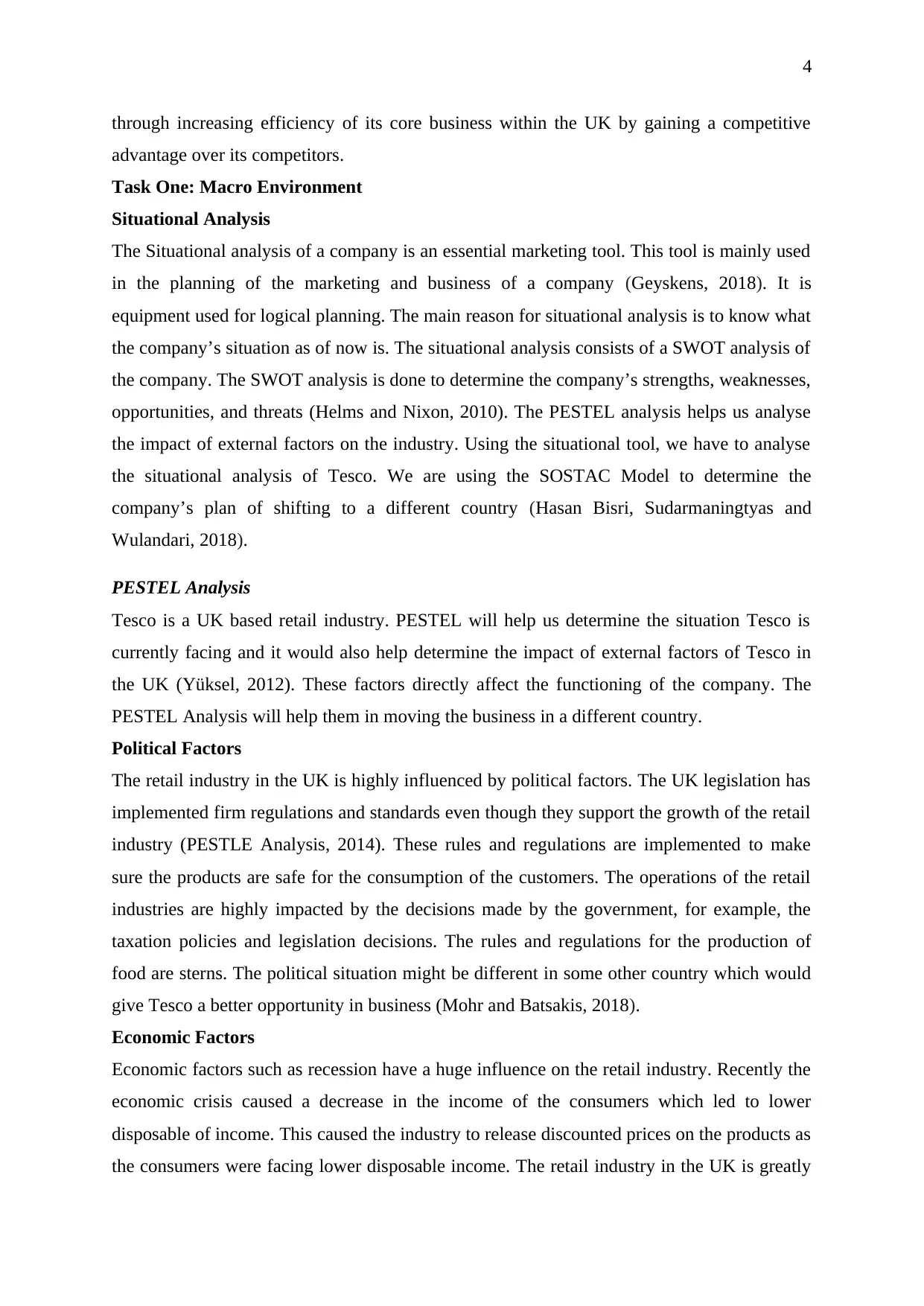
4
through increasing efficiency of its core business within the UK by gaining a competitive
advantage over its competitors.
Task One: Macro Environment
Situational Analysis
The Situational analysis of a company is an essential marketing tool. This tool is mainly used
in the planning of the marketing and business of a company (Geyskens, 2018). It is
equipment used for logical planning. The main reason for situational analysis is to know what
the company’s situation as of now is. The situational analysis consists of a SWOT analysis of
the company. The SWOT analysis is done to determine the company’s strengths, weaknesses,
opportunities, and threats (Helms and Nixon, 2010). The PESTEL analysis helps us analyse
the impact of external factors on the industry. Using the situational tool, we have to analyse
the situational analysis of Tesco. We are using the SOSTAC Model to determine the
company’s plan of shifting to a different country (Hasan Bisri, Sudarmaningtyas and
Wulandari, 2018).
PESTEL Analysis
Tesco is a UK based retail industry. PESTEL will help us determine the situation Tesco is
currently facing and it would also help determine the impact of external factors of Tesco in
the UK (Yüksel, 2012). These factors directly affect the functioning of the company. The
PESTEL Analysis will help them in moving the business in a different country.
Political Factors
The retail industry in the UK is highly influenced by political factors. The UK legislation has
implemented firm regulations and standards even though they support the growth of the retail
industry (PESTLE Analysis, 2014). These rules and regulations are implemented to make
sure the products are safe for the consumption of the customers. The operations of the retail
industries are highly impacted by the decisions made by the government, for example, the
taxation policies and legislation decisions. The rules and regulations for the production of
food are sterns. The political situation might be different in some other country which would
give Tesco a better opportunity in business (Mohr and Batsakis, 2018).
Economic Factors
Economic factors such as recession have a huge influence on the retail industry. Recently the
economic crisis caused a decrease in the income of the consumers which led to lower
disposable of income. This caused the industry to release discounted prices on the products as
the consumers were facing lower disposable income. The retail industry in the UK is greatly
through increasing efficiency of its core business within the UK by gaining a competitive
advantage over its competitors.
Task One: Macro Environment
Situational Analysis
The Situational analysis of a company is an essential marketing tool. This tool is mainly used
in the planning of the marketing and business of a company (Geyskens, 2018). It is
equipment used for logical planning. The main reason for situational analysis is to know what
the company’s situation as of now is. The situational analysis consists of a SWOT analysis of
the company. The SWOT analysis is done to determine the company’s strengths, weaknesses,
opportunities, and threats (Helms and Nixon, 2010). The PESTEL analysis helps us analyse
the impact of external factors on the industry. Using the situational tool, we have to analyse
the situational analysis of Tesco. We are using the SOSTAC Model to determine the
company’s plan of shifting to a different country (Hasan Bisri, Sudarmaningtyas and
Wulandari, 2018).
PESTEL Analysis
Tesco is a UK based retail industry. PESTEL will help us determine the situation Tesco is
currently facing and it would also help determine the impact of external factors of Tesco in
the UK (Yüksel, 2012). These factors directly affect the functioning of the company. The
PESTEL Analysis will help them in moving the business in a different country.
Political Factors
The retail industry in the UK is highly influenced by political factors. The UK legislation has
implemented firm regulations and standards even though they support the growth of the retail
industry (PESTLE Analysis, 2014). These rules and regulations are implemented to make
sure the products are safe for the consumption of the customers. The operations of the retail
industries are highly impacted by the decisions made by the government, for example, the
taxation policies and legislation decisions. The rules and regulations for the production of
food are sterns. The political situation might be different in some other country which would
give Tesco a better opportunity in business (Mohr and Batsakis, 2018).
Economic Factors
Economic factors such as recession have a huge influence on the retail industry. Recently the
economic crisis caused a decrease in the income of the consumers which led to lower
disposable of income. This caused the industry to release discounted prices on the products as
the consumers were facing lower disposable income. The retail industry in the UK is greatly
Paraphrase This Document
Need a fresh take? Get an instant paraphrase of this document with our AI Paraphraser
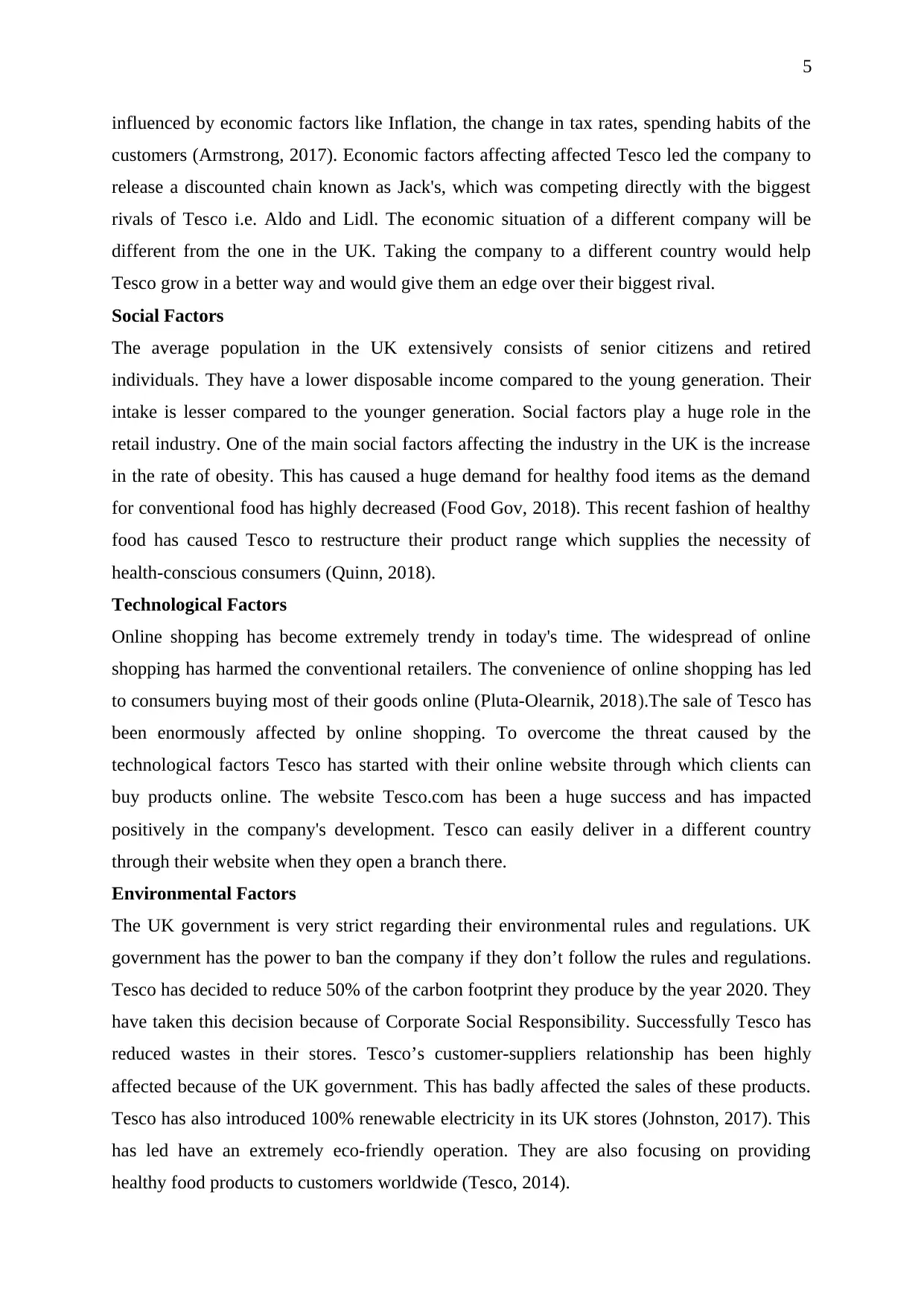
5
influenced by economic factors like Inflation, the change in tax rates, spending habits of the
customers (Armstrong, 2017). Economic factors affecting affected Tesco led the company to
release a discounted chain known as Jack's, which was competing directly with the biggest
rivals of Tesco i.e. Aldo and Lidl. The economic situation of a different company will be
different from the one in the UK. Taking the company to a different country would help
Tesco grow in a better way and would give them an edge over their biggest rival.
Social Factors
The average population in the UK extensively consists of senior citizens and retired
individuals. They have a lower disposable income compared to the young generation. Their
intake is lesser compared to the younger generation. Social factors play a huge role in the
retail industry. One of the main social factors affecting the industry in the UK is the increase
in the rate of obesity. This has caused a huge demand for healthy food items as the demand
for conventional food has highly decreased (Food Gov, 2018). This recent fashion of healthy
food has caused Tesco to restructure their product range which supplies the necessity of
health-conscious consumers (Quinn, 2018).
Technological Factors
Online shopping has become extremely trendy in today's time. The widespread of online
shopping has harmed the conventional retailers. The convenience of online shopping has led
to consumers buying most of their goods online (Pluta-Olearnik, 2018).The sale of Tesco has
been enormously affected by online shopping. To overcome the threat caused by the
technological factors Tesco has started with their online website through which clients can
buy products online. The website Tesco.com has been a huge success and has impacted
positively in the company's development. Tesco can easily deliver in a different country
through their website when they open a branch there.
Environmental Factors
The UK government is very strict regarding their environmental rules and regulations. UK
government has the power to ban the company if they don’t follow the rules and regulations.
Tesco has decided to reduce 50% of the carbon footprint they produce by the year 2020. They
have taken this decision because of Corporate Social Responsibility. Successfully Tesco has
reduced wastes in their stores. Tesco’s customer-suppliers relationship has been highly
affected because of the UK government. This has badly affected the sales of these products.
Tesco has also introduced 100% renewable electricity in its UK stores (Johnston, 2017). This
has led have an extremely eco-friendly operation. They are also focusing on providing
healthy food products to customers worldwide (Tesco, 2014).
influenced by economic factors like Inflation, the change in tax rates, spending habits of the
customers (Armstrong, 2017). Economic factors affecting affected Tesco led the company to
release a discounted chain known as Jack's, which was competing directly with the biggest
rivals of Tesco i.e. Aldo and Lidl. The economic situation of a different company will be
different from the one in the UK. Taking the company to a different country would help
Tesco grow in a better way and would give them an edge over their biggest rival.
Social Factors
The average population in the UK extensively consists of senior citizens and retired
individuals. They have a lower disposable income compared to the young generation. Their
intake is lesser compared to the younger generation. Social factors play a huge role in the
retail industry. One of the main social factors affecting the industry in the UK is the increase
in the rate of obesity. This has caused a huge demand for healthy food items as the demand
for conventional food has highly decreased (Food Gov, 2018). This recent fashion of healthy
food has caused Tesco to restructure their product range which supplies the necessity of
health-conscious consumers (Quinn, 2018).
Technological Factors
Online shopping has become extremely trendy in today's time. The widespread of online
shopping has harmed the conventional retailers. The convenience of online shopping has led
to consumers buying most of their goods online (Pluta-Olearnik, 2018).The sale of Tesco has
been enormously affected by online shopping. To overcome the threat caused by the
technological factors Tesco has started with their online website through which clients can
buy products online. The website Tesco.com has been a huge success and has impacted
positively in the company's development. Tesco can easily deliver in a different country
through their website when they open a branch there.
Environmental Factors
The UK government is very strict regarding their environmental rules and regulations. UK
government has the power to ban the company if they don’t follow the rules and regulations.
Tesco has decided to reduce 50% of the carbon footprint they produce by the year 2020. They
have taken this decision because of Corporate Social Responsibility. Successfully Tesco has
reduced wastes in their stores. Tesco’s customer-suppliers relationship has been highly
affected because of the UK government. This has badly affected the sales of these products.
Tesco has also introduced 100% renewable electricity in its UK stores (Johnston, 2017). This
has led have an extremely eco-friendly operation. They are also focusing on providing
healthy food products to customers worldwide (Tesco, 2014).
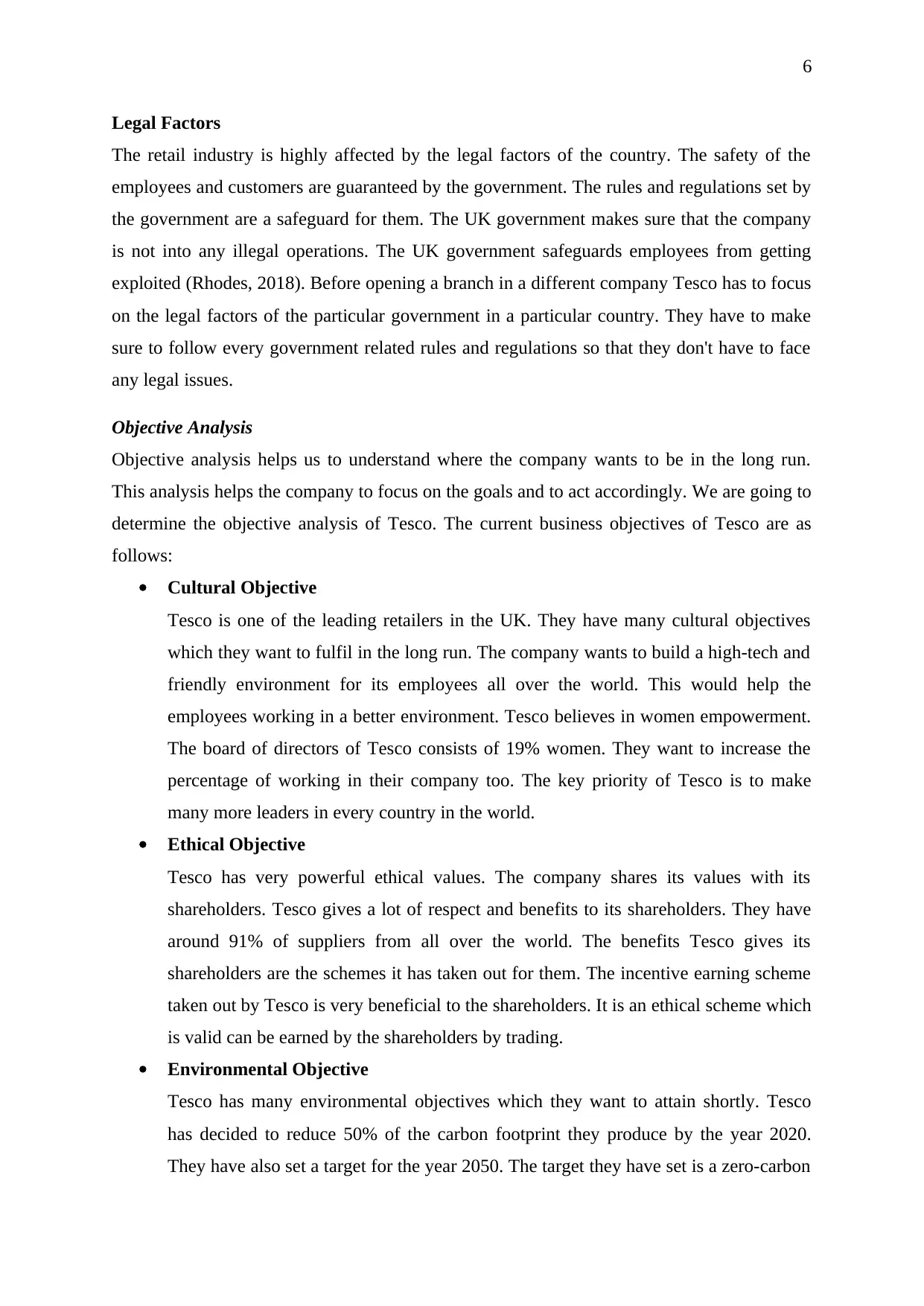
6
Legal Factors
The retail industry is highly affected by the legal factors of the country. The safety of the
employees and customers are guaranteed by the government. The rules and regulations set by
the government are a safeguard for them. The UK government makes sure that the company
is not into any illegal operations. The UK government safeguards employees from getting
exploited (Rhodes, 2018). Before opening a branch in a different company Tesco has to focus
on the legal factors of the particular government in a particular country. They have to make
sure to follow every government related rules and regulations so that they don't have to face
any legal issues.
Objective Analysis
Objective analysis helps us to understand where the company wants to be in the long run.
This analysis helps the company to focus on the goals and to act accordingly. We are going to
determine the objective analysis of Tesco. The current business objectives of Tesco are as
follows:
Cultural Objective
Tesco is one of the leading retailers in the UK. They have many cultural objectives
which they want to fulfil in the long run. The company wants to build a high-tech and
friendly environment for its employees all over the world. This would help the
employees working in a better environment. Tesco believes in women empowerment.
The board of directors of Tesco consists of 19% women. They want to increase the
percentage of working in their company too. The key priority of Tesco is to make
many more leaders in every country in the world.
Ethical Objective
Tesco has very powerful ethical values. The company shares its values with its
shareholders. Tesco gives a lot of respect and benefits to its shareholders. They have
around 91% of suppliers from all over the world. The benefits Tesco gives its
shareholders are the schemes it has taken out for them. The incentive earning scheme
taken out by Tesco is very beneficial to the shareholders. It is an ethical scheme which
is valid can be earned by the shareholders by trading.
Environmental Objective
Tesco has many environmental objectives which they want to attain shortly. Tesco
has decided to reduce 50% of the carbon footprint they produce by the year 2020.
They have also set a target for the year 2050. The target they have set is a zero-carbon
Legal Factors
The retail industry is highly affected by the legal factors of the country. The safety of the
employees and customers are guaranteed by the government. The rules and regulations set by
the government are a safeguard for them. The UK government makes sure that the company
is not into any illegal operations. The UK government safeguards employees from getting
exploited (Rhodes, 2018). Before opening a branch in a different company Tesco has to focus
on the legal factors of the particular government in a particular country. They have to make
sure to follow every government related rules and regulations so that they don't have to face
any legal issues.
Objective Analysis
Objective analysis helps us to understand where the company wants to be in the long run.
This analysis helps the company to focus on the goals and to act accordingly. We are going to
determine the objective analysis of Tesco. The current business objectives of Tesco are as
follows:
Cultural Objective
Tesco is one of the leading retailers in the UK. They have many cultural objectives
which they want to fulfil in the long run. The company wants to build a high-tech and
friendly environment for its employees all over the world. This would help the
employees working in a better environment. Tesco believes in women empowerment.
The board of directors of Tesco consists of 19% women. They want to increase the
percentage of working in their company too. The key priority of Tesco is to make
many more leaders in every country in the world.
Ethical Objective
Tesco has very powerful ethical values. The company shares its values with its
shareholders. Tesco gives a lot of respect and benefits to its shareholders. They have
around 91% of suppliers from all over the world. The benefits Tesco gives its
shareholders are the schemes it has taken out for them. The incentive earning scheme
taken out by Tesco is very beneficial to the shareholders. It is an ethical scheme which
is valid can be earned by the shareholders by trading.
Environmental Objective
Tesco has many environmental objectives which they want to attain shortly. Tesco
has decided to reduce 50% of the carbon footprint they produce by the year 2020.
They have also set a target for the year 2050. The target they have set is a zero-carbon
⊘ This is a preview!⊘
Do you want full access?
Subscribe today to unlock all pages.

Trusted by 1+ million students worldwide
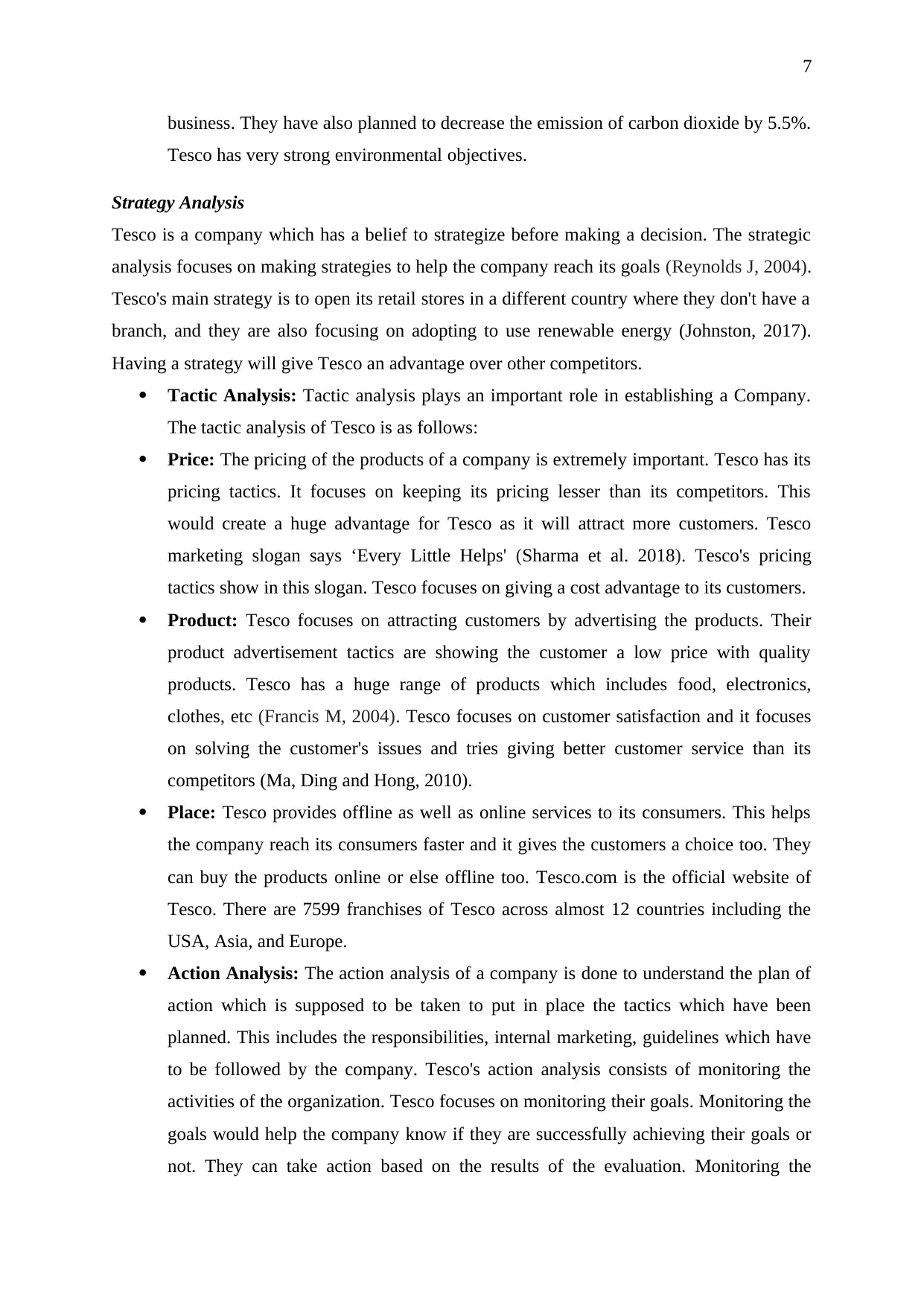
7
business. They have also planned to decrease the emission of carbon dioxide by 5.5%.
Tesco has very strong environmental objectives.
Strategy Analysis
Tesco is a company which has a belief to strategize before making a decision. The strategic
analysis focuses on making strategies to help the company reach its goals (Reynolds J, 2004).
Tesco's main strategy is to open its retail stores in a different country where they don't have a
branch, and they are also focusing on adopting to use renewable energy (Johnston, 2017).
Having a strategy will give Tesco an advantage over other competitors.
Tactic Analysis: Tactic analysis plays an important role in establishing a Company.
The tactic analysis of Tesco is as follows:
Price: The pricing of the products of a company is extremely important. Tesco has its
pricing tactics. It focuses on keeping its pricing lesser than its competitors. This
would create a huge advantage for Tesco as it will attract more customers. Tesco
marketing slogan says ‘Every Little Helps' (Sharma et al. 2018). Tesco's pricing
tactics show in this slogan. Tesco focuses on giving a cost advantage to its customers.
Product: Tesco focuses on attracting customers by advertising the products. Their
product advertisement tactics are showing the customer a low price with quality
products. Tesco has a huge range of products which includes food, electronics,
clothes, etc (Francis M, 2004). Tesco focuses on customer satisfaction and it focuses
on solving the customer's issues and tries giving better customer service than its
competitors (Ma, Ding and Hong, 2010).
Place: Tesco provides offline as well as online services to its consumers. This helps
the company reach its consumers faster and it gives the customers a choice too. They
can buy the products online or else offline too. Tesco.com is the official website of
Tesco. There are 7599 franchises of Tesco across almost 12 countries including the
USA, Asia, and Europe.
Action Analysis: The action analysis of a company is done to understand the plan of
action which is supposed to be taken to put in place the tactics which have been
planned. This includes the responsibilities, internal marketing, guidelines which have
to be followed by the company. Tesco's action analysis consists of monitoring the
activities of the organization. Tesco focuses on monitoring their goals. Monitoring the
goals would help the company know if they are successfully achieving their goals or
not. They can take action based on the results of the evaluation. Monitoring the
business. They have also planned to decrease the emission of carbon dioxide by 5.5%.
Tesco has very strong environmental objectives.
Strategy Analysis
Tesco is a company which has a belief to strategize before making a decision. The strategic
analysis focuses on making strategies to help the company reach its goals (Reynolds J, 2004).
Tesco's main strategy is to open its retail stores in a different country where they don't have a
branch, and they are also focusing on adopting to use renewable energy (Johnston, 2017).
Having a strategy will give Tesco an advantage over other competitors.
Tactic Analysis: Tactic analysis plays an important role in establishing a Company.
The tactic analysis of Tesco is as follows:
Price: The pricing of the products of a company is extremely important. Tesco has its
pricing tactics. It focuses on keeping its pricing lesser than its competitors. This
would create a huge advantage for Tesco as it will attract more customers. Tesco
marketing slogan says ‘Every Little Helps' (Sharma et al. 2018). Tesco's pricing
tactics show in this slogan. Tesco focuses on giving a cost advantage to its customers.
Product: Tesco focuses on attracting customers by advertising the products. Their
product advertisement tactics are showing the customer a low price with quality
products. Tesco has a huge range of products which includes food, electronics,
clothes, etc (Francis M, 2004). Tesco focuses on customer satisfaction and it focuses
on solving the customer's issues and tries giving better customer service than its
competitors (Ma, Ding and Hong, 2010).
Place: Tesco provides offline as well as online services to its consumers. This helps
the company reach its consumers faster and it gives the customers a choice too. They
can buy the products online or else offline too. Tesco.com is the official website of
Tesco. There are 7599 franchises of Tesco across almost 12 countries including the
USA, Asia, and Europe.
Action Analysis: The action analysis of a company is done to understand the plan of
action which is supposed to be taken to put in place the tactics which have been
planned. This includes the responsibilities, internal marketing, guidelines which have
to be followed by the company. Tesco's action analysis consists of monitoring the
activities of the organization. Tesco focuses on monitoring their goals. Monitoring the
goals would help the company know if they are successfully achieving their goals or
not. They can take action based on the results of the evaluation. Monitoring the
Paraphrase This Document
Need a fresh take? Get an instant paraphrase of this document with our AI Paraphraser
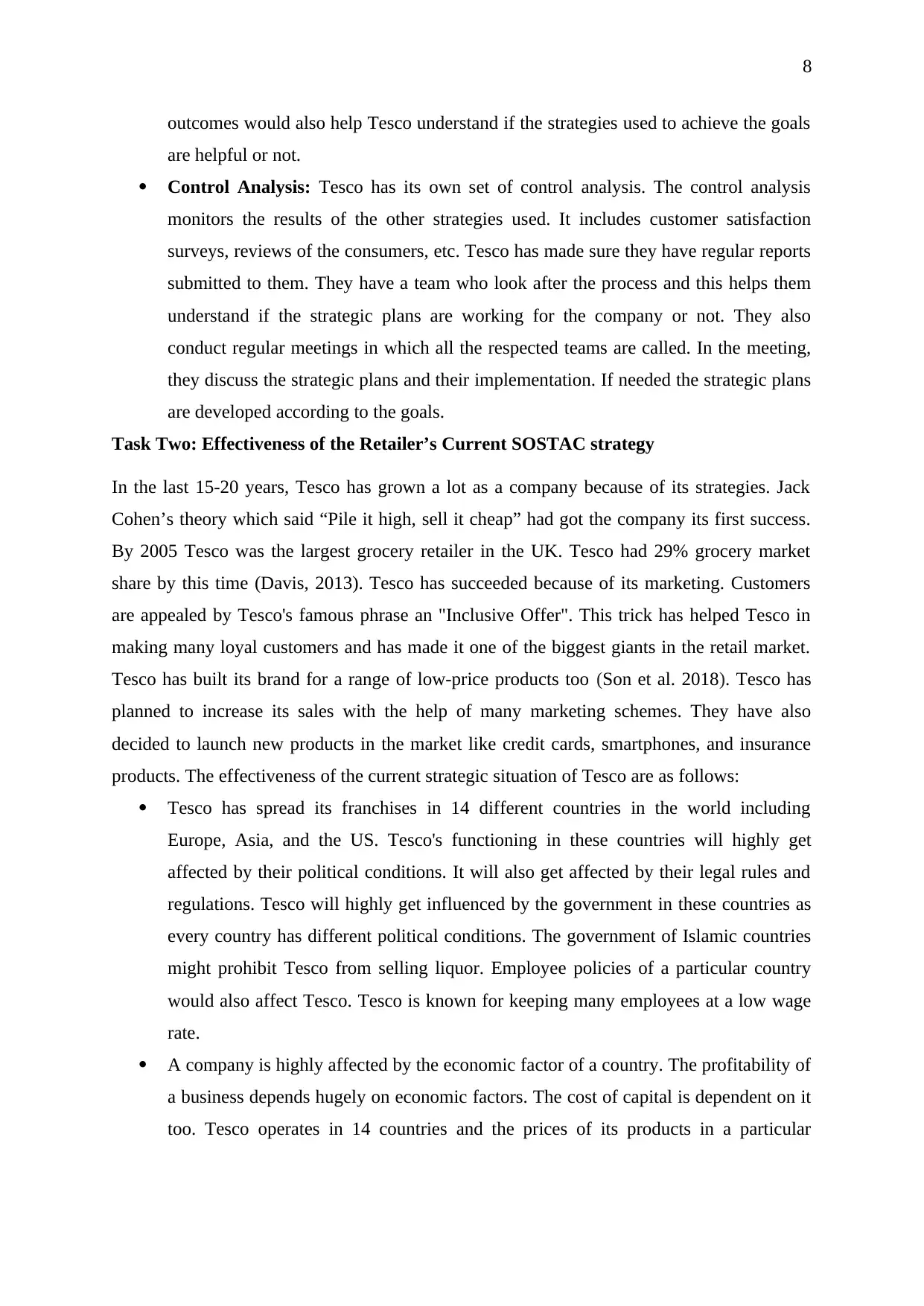
8
outcomes would also help Tesco understand if the strategies used to achieve the goals
are helpful or not.
Control Analysis: Tesco has its own set of control analysis. The control analysis
monitors the results of the other strategies used. It includes customer satisfaction
surveys, reviews of the consumers, etc. Tesco has made sure they have regular reports
submitted to them. They have a team who look after the process and this helps them
understand if the strategic plans are working for the company or not. They also
conduct regular meetings in which all the respected teams are called. In the meeting,
they discuss the strategic plans and their implementation. If needed the strategic plans
are developed according to the goals.
Task Two: Effectiveness of the Retailer’s Current SOSTAC strategy
In the last 15-20 years, Tesco has grown a lot as a company because of its strategies. Jack
Cohen’s theory which said “Pile it high, sell it cheap” had got the company its first success.
By 2005 Tesco was the largest grocery retailer in the UK. Tesco had 29% grocery market
share by this time (Davis, 2013). Tesco has succeeded because of its marketing. Customers
are appealed by Tesco's famous phrase an "Inclusive Offer". This trick has helped Tesco in
making many loyal customers and has made it one of the biggest giants in the retail market.
Tesco has built its brand for a range of low-price products too (Son et al. 2018). Tesco has
planned to increase its sales with the help of many marketing schemes. They have also
decided to launch new products in the market like credit cards, smartphones, and insurance
products. The effectiveness of the current strategic situation of Tesco are as follows:
Tesco has spread its franchises in 14 different countries in the world including
Europe, Asia, and the US. Tesco's functioning in these countries will highly get
affected by their political conditions. It will also get affected by their legal rules and
regulations. Tesco will highly get influenced by the government in these countries as
every country has different political conditions. The government of Islamic countries
might prohibit Tesco from selling liquor. Employee policies of a particular country
would also affect Tesco. Tesco is known for keeping many employees at a low wage
rate.
A company is highly affected by the economic factor of a country. The profitability of
a business depends hugely on economic factors. The cost of capital is dependent on it
too. Tesco operates in 14 countries and the prices of its products in a particular
outcomes would also help Tesco understand if the strategies used to achieve the goals
are helpful or not.
Control Analysis: Tesco has its own set of control analysis. The control analysis
monitors the results of the other strategies used. It includes customer satisfaction
surveys, reviews of the consumers, etc. Tesco has made sure they have regular reports
submitted to them. They have a team who look after the process and this helps them
understand if the strategic plans are working for the company or not. They also
conduct regular meetings in which all the respected teams are called. In the meeting,
they discuss the strategic plans and their implementation. If needed the strategic plans
are developed according to the goals.
Task Two: Effectiveness of the Retailer’s Current SOSTAC strategy
In the last 15-20 years, Tesco has grown a lot as a company because of its strategies. Jack
Cohen’s theory which said “Pile it high, sell it cheap” had got the company its first success.
By 2005 Tesco was the largest grocery retailer in the UK. Tesco had 29% grocery market
share by this time (Davis, 2013). Tesco has succeeded because of its marketing. Customers
are appealed by Tesco's famous phrase an "Inclusive Offer". This trick has helped Tesco in
making many loyal customers and has made it one of the biggest giants in the retail market.
Tesco has built its brand for a range of low-price products too (Son et al. 2018). Tesco has
planned to increase its sales with the help of many marketing schemes. They have also
decided to launch new products in the market like credit cards, smartphones, and insurance
products. The effectiveness of the current strategic situation of Tesco are as follows:
Tesco has spread its franchises in 14 different countries in the world including
Europe, Asia, and the US. Tesco's functioning in these countries will highly get
affected by their political conditions. It will also get affected by their legal rules and
regulations. Tesco will highly get influenced by the government in these countries as
every country has different political conditions. The government of Islamic countries
might prohibit Tesco from selling liquor. Employee policies of a particular country
would also affect Tesco. Tesco is known for keeping many employees at a low wage
rate.
A company is highly affected by the economic factor of a country. The profitability of
a business depends hugely on economic factors. The cost of capital is dependent on it
too. Tesco operates in 14 countries and the prices of its products in a particular
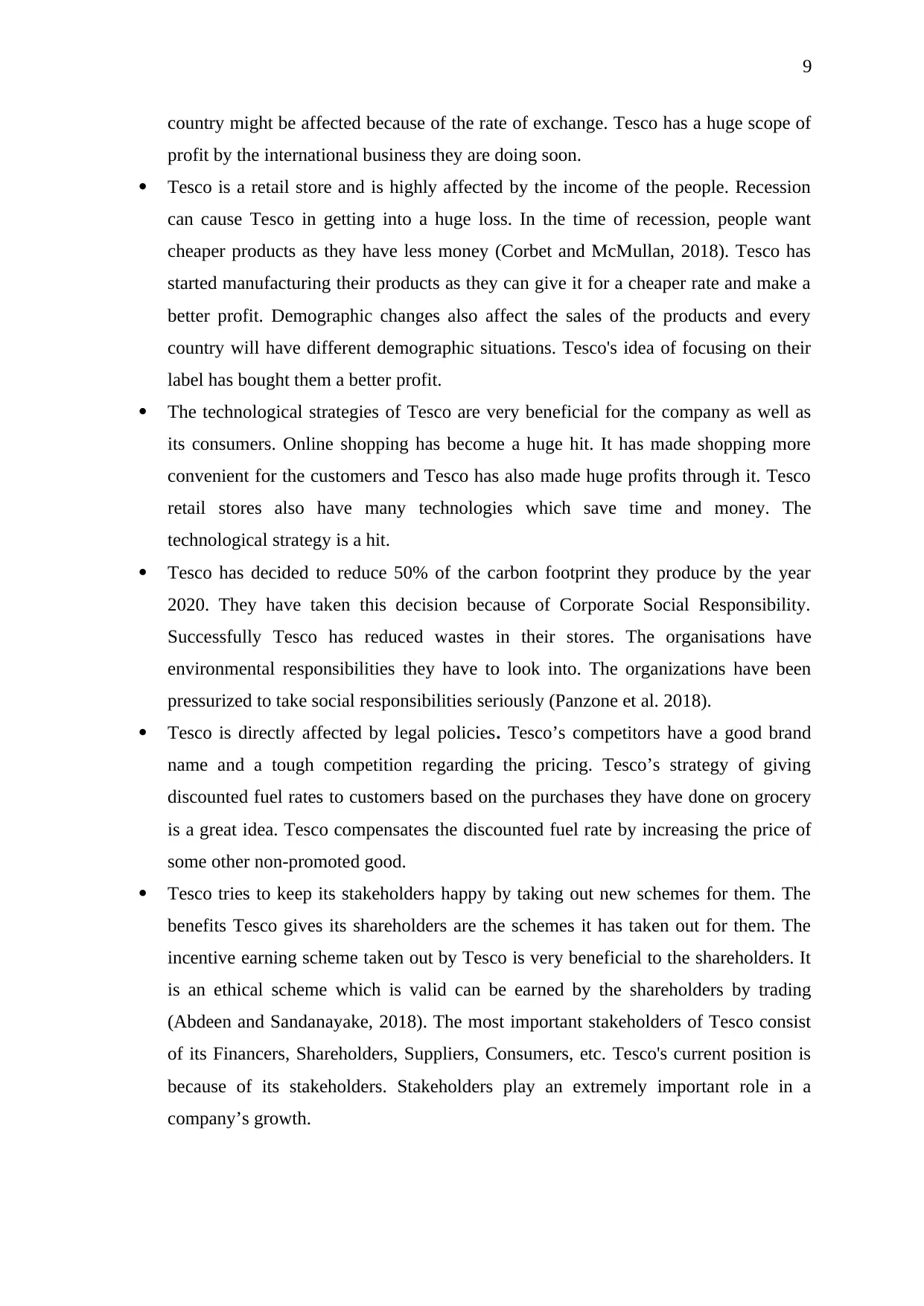
9
country might be affected because of the rate of exchange. Tesco has a huge scope of
profit by the international business they are doing soon.
Tesco is a retail store and is highly affected by the income of the people. Recession
can cause Tesco in getting into a huge loss. In the time of recession, people want
cheaper products as they have less money (Corbet and McMullan, 2018). Tesco has
started manufacturing their products as they can give it for a cheaper rate and make a
better profit. Demographic changes also affect the sales of the products and every
country will have different demographic situations. Tesco's idea of focusing on their
label has bought them a better profit.
The technological strategies of Tesco are very beneficial for the company as well as
its consumers. Online shopping has become a huge hit. It has made shopping more
convenient for the customers and Tesco has also made huge profits through it. Tesco
retail stores also have many technologies which save time and money. The
technological strategy is a hit.
Tesco has decided to reduce 50% of the carbon footprint they produce by the year
2020. They have taken this decision because of Corporate Social Responsibility.
Successfully Tesco has reduced wastes in their stores. The organisations have
environmental responsibilities they have to look into. The organizations have been
pressurized to take social responsibilities seriously (Panzone et al. 2018).
Tesco is directly affected by legal policies. Tesco’s competitors have a good brand
name and a tough competition regarding the pricing. Tesco’s strategy of giving
discounted fuel rates to customers based on the purchases they have done on grocery
is a great idea. Tesco compensates the discounted fuel rate by increasing the price of
some other non-promoted good.
Tesco tries to keep its stakeholders happy by taking out new schemes for them. The
benefits Tesco gives its shareholders are the schemes it has taken out for them. The
incentive earning scheme taken out by Tesco is very beneficial to the shareholders. It
is an ethical scheme which is valid can be earned by the shareholders by trading
(Abdeen and Sandanayake, 2018). The most important stakeholders of Tesco consist
of its Financers, Shareholders, Suppliers, Consumers, etc. Tesco's current position is
because of its stakeholders. Stakeholders play an extremely important role in a
company’s growth.
country might be affected because of the rate of exchange. Tesco has a huge scope of
profit by the international business they are doing soon.
Tesco is a retail store and is highly affected by the income of the people. Recession
can cause Tesco in getting into a huge loss. In the time of recession, people want
cheaper products as they have less money (Corbet and McMullan, 2018). Tesco has
started manufacturing their products as they can give it for a cheaper rate and make a
better profit. Demographic changes also affect the sales of the products and every
country will have different demographic situations. Tesco's idea of focusing on their
label has bought them a better profit.
The technological strategies of Tesco are very beneficial for the company as well as
its consumers. Online shopping has become a huge hit. It has made shopping more
convenient for the customers and Tesco has also made huge profits through it. Tesco
retail stores also have many technologies which save time and money. The
technological strategy is a hit.
Tesco has decided to reduce 50% of the carbon footprint they produce by the year
2020. They have taken this decision because of Corporate Social Responsibility.
Successfully Tesco has reduced wastes in their stores. The organisations have
environmental responsibilities they have to look into. The organizations have been
pressurized to take social responsibilities seriously (Panzone et al. 2018).
Tesco is directly affected by legal policies. Tesco’s competitors have a good brand
name and a tough competition regarding the pricing. Tesco’s strategy of giving
discounted fuel rates to customers based on the purchases they have done on grocery
is a great idea. Tesco compensates the discounted fuel rate by increasing the price of
some other non-promoted good.
Tesco tries to keep its stakeholders happy by taking out new schemes for them. The
benefits Tesco gives its shareholders are the schemes it has taken out for them. The
incentive earning scheme taken out by Tesco is very beneficial to the shareholders. It
is an ethical scheme which is valid can be earned by the shareholders by trading
(Abdeen and Sandanayake, 2018). The most important stakeholders of Tesco consist
of its Financers, Shareholders, Suppliers, Consumers, etc. Tesco's current position is
because of its stakeholders. Stakeholders play an extremely important role in a
company’s growth.
⊘ This is a preview!⊘
Do you want full access?
Subscribe today to unlock all pages.

Trusted by 1+ million students worldwide
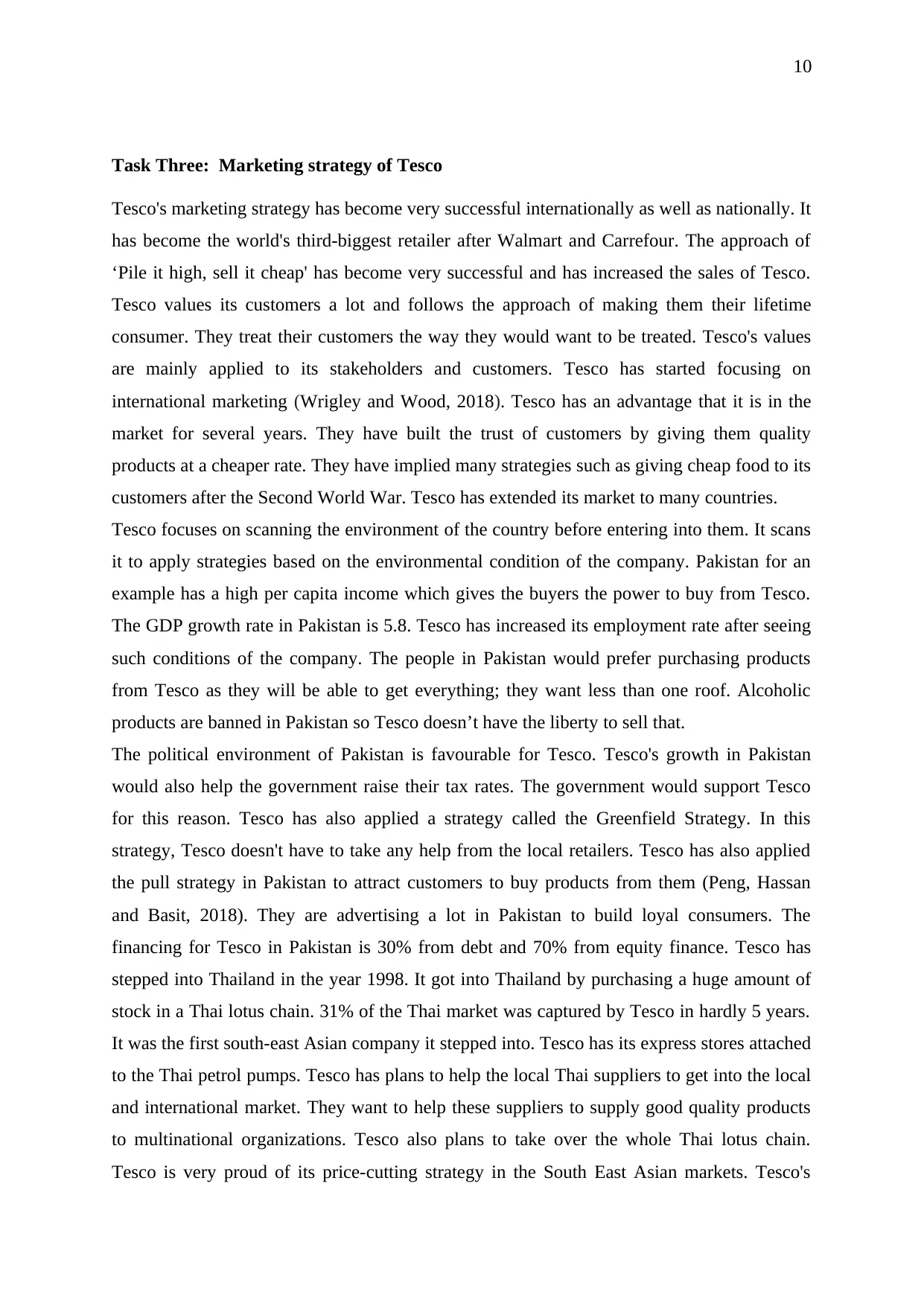
10
Task Three: Marketing strategy of Tesco
Tesco's marketing strategy has become very successful internationally as well as nationally. It
has become the world's third-biggest retailer after Walmart and Carrefour. The approach of
‘Pile it high, sell it cheap' has become very successful and has increased the sales of Tesco.
Tesco values its customers a lot and follows the approach of making them their lifetime
consumer. They treat their customers the way they would want to be treated. Tesco's values
are mainly applied to its stakeholders and customers. Tesco has started focusing on
international marketing (Wrigley and Wood, 2018). Tesco has an advantage that it is in the
market for several years. They have built the trust of customers by giving them quality
products at a cheaper rate. They have implied many strategies such as giving cheap food to its
customers after the Second World War. Tesco has extended its market to many countries.
Tesco focuses on scanning the environment of the country before entering into them. It scans
it to apply strategies based on the environmental condition of the company. Pakistan for an
example has a high per capita income which gives the buyers the power to buy from Tesco.
The GDP growth rate in Pakistan is 5.8. Tesco has increased its employment rate after seeing
such conditions of the company. The people in Pakistan would prefer purchasing products
from Tesco as they will be able to get everything; they want less than one roof. Alcoholic
products are banned in Pakistan so Tesco doesn’t have the liberty to sell that.
The political environment of Pakistan is favourable for Tesco. Tesco's growth in Pakistan
would also help the government raise their tax rates. The government would support Tesco
for this reason. Tesco has also applied a strategy called the Greenfield Strategy. In this
strategy, Tesco doesn't have to take any help from the local retailers. Tesco has also applied
the pull strategy in Pakistan to attract customers to buy products from them (Peng, Hassan
and Basit, 2018). They are advertising a lot in Pakistan to build loyal consumers. The
financing for Tesco in Pakistan is 30% from debt and 70% from equity finance. Tesco has
stepped into Thailand in the year 1998. It got into Thailand by purchasing a huge amount of
stock in a Thai lotus chain. 31% of the Thai market was captured by Tesco in hardly 5 years.
It was the first south-east Asian company it stepped into. Tesco has its express stores attached
to the Thai petrol pumps. Tesco has plans to help the local Thai suppliers to get into the local
and international market. They want to help these suppliers to supply good quality products
to multinational organizations. Tesco also plans to take over the whole Thai lotus chain.
Tesco is very proud of its price-cutting strategy in the South East Asian markets. Tesco's
Task Three: Marketing strategy of Tesco
Tesco's marketing strategy has become very successful internationally as well as nationally. It
has become the world's third-biggest retailer after Walmart and Carrefour. The approach of
‘Pile it high, sell it cheap' has become very successful and has increased the sales of Tesco.
Tesco values its customers a lot and follows the approach of making them their lifetime
consumer. They treat their customers the way they would want to be treated. Tesco's values
are mainly applied to its stakeholders and customers. Tesco has started focusing on
international marketing (Wrigley and Wood, 2018). Tesco has an advantage that it is in the
market for several years. They have built the trust of customers by giving them quality
products at a cheaper rate. They have implied many strategies such as giving cheap food to its
customers after the Second World War. Tesco has extended its market to many countries.
Tesco focuses on scanning the environment of the country before entering into them. It scans
it to apply strategies based on the environmental condition of the company. Pakistan for an
example has a high per capita income which gives the buyers the power to buy from Tesco.
The GDP growth rate in Pakistan is 5.8. Tesco has increased its employment rate after seeing
such conditions of the company. The people in Pakistan would prefer purchasing products
from Tesco as they will be able to get everything; they want less than one roof. Alcoholic
products are banned in Pakistan so Tesco doesn’t have the liberty to sell that.
The political environment of Pakistan is favourable for Tesco. Tesco's growth in Pakistan
would also help the government raise their tax rates. The government would support Tesco
for this reason. Tesco has also applied a strategy called the Greenfield Strategy. In this
strategy, Tesco doesn't have to take any help from the local retailers. Tesco has also applied
the pull strategy in Pakistan to attract customers to buy products from them (Peng, Hassan
and Basit, 2018). They are advertising a lot in Pakistan to build loyal consumers. The
financing for Tesco in Pakistan is 30% from debt and 70% from equity finance. Tesco has
stepped into Thailand in the year 1998. It got into Thailand by purchasing a huge amount of
stock in a Thai lotus chain. 31% of the Thai market was captured by Tesco in hardly 5 years.
It was the first south-east Asian company it stepped into. Tesco has its express stores attached
to the Thai petrol pumps. Tesco has plans to help the local Thai suppliers to get into the local
and international market. They want to help these suppliers to supply good quality products
to multinational organizations. Tesco also plans to take over the whole Thai lotus chain.
Tesco is very proud of its price-cutting strategy in the South East Asian markets. Tesco's
Paraphrase This Document
Need a fresh take? Get an instant paraphrase of this document with our AI Paraphraser
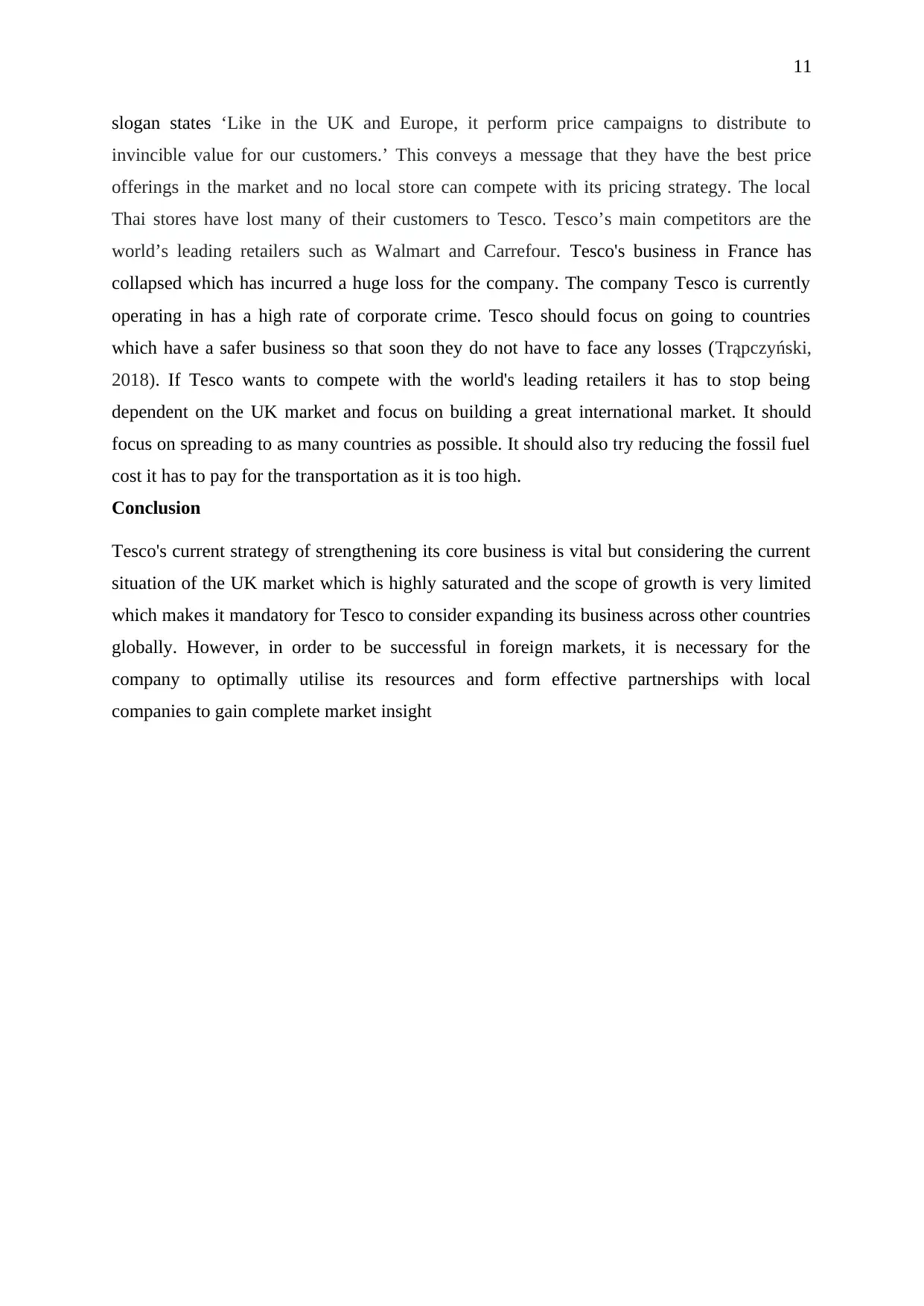
11
slogan states ‘Like in the UK and Europe, it perform price campaigns to distribute to
invincible value for our customers.’ This conveys a message that they have the best price
offerings in the market and no local store can compete with its pricing strategy. The local
Thai stores have lost many of their customers to Tesco. Tesco’s main competitors are the
world’s leading retailers such as Walmart and Carrefour. Tesco's business in France has
collapsed which has incurred a huge loss for the company. The company Tesco is currently
operating in has a high rate of corporate crime. Tesco should focus on going to countries
which have a safer business so that soon they do not have to face any losses (Trąpczyński,
2018). If Tesco wants to compete with the world's leading retailers it has to stop being
dependent on the UK market and focus on building a great international market. It should
focus on spreading to as many countries as possible. It should also try reducing the fossil fuel
cost it has to pay for the transportation as it is too high.
Conclusion
Tesco's current strategy of strengthening its core business is vital but considering the current
situation of the UK market which is highly saturated and the scope of growth is very limited
which makes it mandatory for Tesco to consider expanding its business across other countries
globally. However, in order to be successful in foreign markets, it is necessary for the
company to optimally utilise its resources and form effective partnerships with local
companies to gain complete market insight
slogan states ‘Like in the UK and Europe, it perform price campaigns to distribute to
invincible value for our customers.’ This conveys a message that they have the best price
offerings in the market and no local store can compete with its pricing strategy. The local
Thai stores have lost many of their customers to Tesco. Tesco’s main competitors are the
world’s leading retailers such as Walmart and Carrefour. Tesco's business in France has
collapsed which has incurred a huge loss for the company. The company Tesco is currently
operating in has a high rate of corporate crime. Tesco should focus on going to countries
which have a safer business so that soon they do not have to face any losses (Trąpczyński,
2018). If Tesco wants to compete with the world's leading retailers it has to stop being
dependent on the UK market and focus on building a great international market. It should
focus on spreading to as many countries as possible. It should also try reducing the fossil fuel
cost it has to pay for the transportation as it is too high.
Conclusion
Tesco's current strategy of strengthening its core business is vital but considering the current
situation of the UK market which is highly saturated and the scope of growth is very limited
which makes it mandatory for Tesco to consider expanding its business across other countries
globally. However, in order to be successful in foreign markets, it is necessary for the
company to optimally utilise its resources and form effective partnerships with local
companies to gain complete market insight
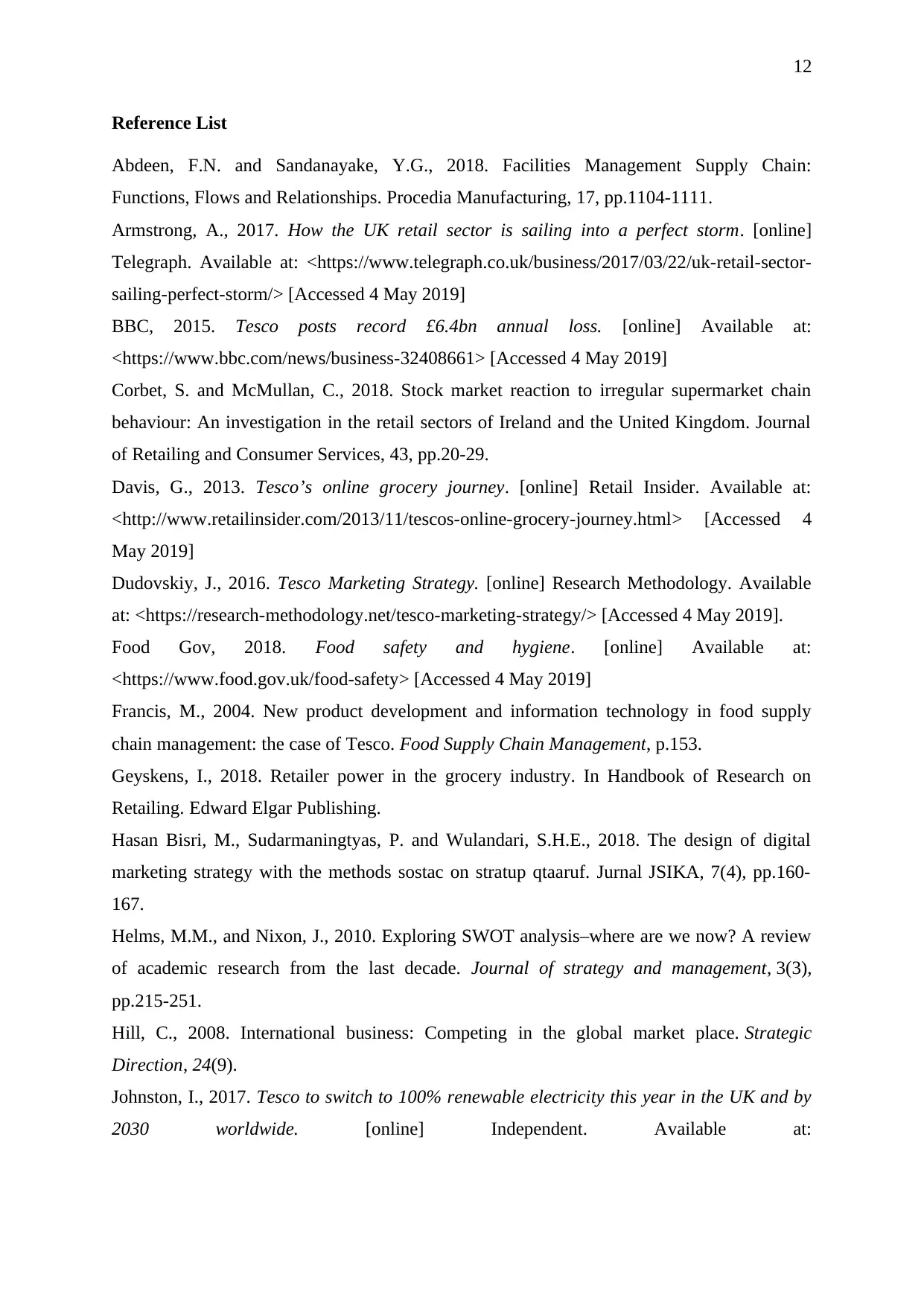
12
Reference List
Abdeen, F.N. and Sandanayake, Y.G., 2018. Facilities Management Supply Chain:
Functions, Flows and Relationships. Procedia Manufacturing, 17, pp.1104-1111.
Armstrong, A., 2017. How the UK retail sector is sailing into a perfect storm. [online]
Telegraph. Available at: <https://www.telegraph.co.uk/business/2017/03/22/uk-retail-sector-
sailing-perfect-storm/> [Accessed 4 May 2019]
BBC, 2015. Tesco posts record £6.4bn annual loss. [online] Available at:
<https://www.bbc.com/news/business-32408661> [Accessed 4 May 2019]
Corbet, S. and McMullan, C., 2018. Stock market reaction to irregular supermarket chain
behaviour: An investigation in the retail sectors of Ireland and the United Kingdom. Journal
of Retailing and Consumer Services, 43, pp.20-29.
Davis, G., 2013. Tesco’s online grocery journey. [online] Retail Insider. Available at:
<http://www.retailinsider.com/2013/11/tescos-online-grocery-journey.html> [Accessed 4
May 2019]
Dudovskiy, J., 2016. Tesco Marketing Strategy. [online] Research Methodology. Available
at: <https://research-methodology.net/tesco-marketing-strategy/> [Accessed 4 May 2019].
Food Gov, 2018. Food safety and hygiene. [online] Available at:
<https://www.food.gov.uk/food-safety> [Accessed 4 May 2019]
Francis, M., 2004. New product development and information technology in food supply
chain management: the case of Tesco. Food Supply Chain Management, p.153.
Geyskens, I., 2018. Retailer power in the grocery industry. In Handbook of Research on
Retailing. Edward Elgar Publishing.
Hasan Bisri, M., Sudarmaningtyas, P. and Wulandari, S.H.E., 2018. The design of digital
marketing strategy with the methods sostac on stratup qtaaruf. Jurnal JSIKA, 7(4), pp.160-
167.
Helms, M.M., and Nixon, J., 2010. Exploring SWOT analysis–where are we now? A review
of academic research from the last decade. Journal of strategy and management, 3(3),
pp.215-251.
Hill, C., 2008. International business: Competing in the global market place. Strategic
Direction, 24(9).
Johnston, I., 2017. Tesco to switch to 100% renewable electricity this year in the UK and by
2030 worldwide. [online] Independent. Available at:
Reference List
Abdeen, F.N. and Sandanayake, Y.G., 2018. Facilities Management Supply Chain:
Functions, Flows and Relationships. Procedia Manufacturing, 17, pp.1104-1111.
Armstrong, A., 2017. How the UK retail sector is sailing into a perfect storm. [online]
Telegraph. Available at: <https://www.telegraph.co.uk/business/2017/03/22/uk-retail-sector-
sailing-perfect-storm/> [Accessed 4 May 2019]
BBC, 2015. Tesco posts record £6.4bn annual loss. [online] Available at:
<https://www.bbc.com/news/business-32408661> [Accessed 4 May 2019]
Corbet, S. and McMullan, C., 2018. Stock market reaction to irregular supermarket chain
behaviour: An investigation in the retail sectors of Ireland and the United Kingdom. Journal
of Retailing and Consumer Services, 43, pp.20-29.
Davis, G., 2013. Tesco’s online grocery journey. [online] Retail Insider. Available at:
<http://www.retailinsider.com/2013/11/tescos-online-grocery-journey.html> [Accessed 4
May 2019]
Dudovskiy, J., 2016. Tesco Marketing Strategy. [online] Research Methodology. Available
at: <https://research-methodology.net/tesco-marketing-strategy/> [Accessed 4 May 2019].
Food Gov, 2018. Food safety and hygiene. [online] Available at:
<https://www.food.gov.uk/food-safety> [Accessed 4 May 2019]
Francis, M., 2004. New product development and information technology in food supply
chain management: the case of Tesco. Food Supply Chain Management, p.153.
Geyskens, I., 2018. Retailer power in the grocery industry. In Handbook of Research on
Retailing. Edward Elgar Publishing.
Hasan Bisri, M., Sudarmaningtyas, P. and Wulandari, S.H.E., 2018. The design of digital
marketing strategy with the methods sostac on stratup qtaaruf. Jurnal JSIKA, 7(4), pp.160-
167.
Helms, M.M., and Nixon, J., 2010. Exploring SWOT analysis–where are we now? A review
of academic research from the last decade. Journal of strategy and management, 3(3),
pp.215-251.
Hill, C., 2008. International business: Competing in the global market place. Strategic
Direction, 24(9).
Johnston, I., 2017. Tesco to switch to 100% renewable electricity this year in the UK and by
2030 worldwide. [online] Independent. Available at:
⊘ This is a preview!⊘
Do you want full access?
Subscribe today to unlock all pages.

Trusted by 1+ million students worldwide
1 out of 14
Related Documents
Your All-in-One AI-Powered Toolkit for Academic Success.
+13062052269
info@desklib.com
Available 24*7 on WhatsApp / Email
![[object Object]](/_next/static/media/star-bottom.7253800d.svg)
Unlock your academic potential
Copyright © 2020–2025 A2Z Services. All Rights Reserved. Developed and managed by ZUCOL.





